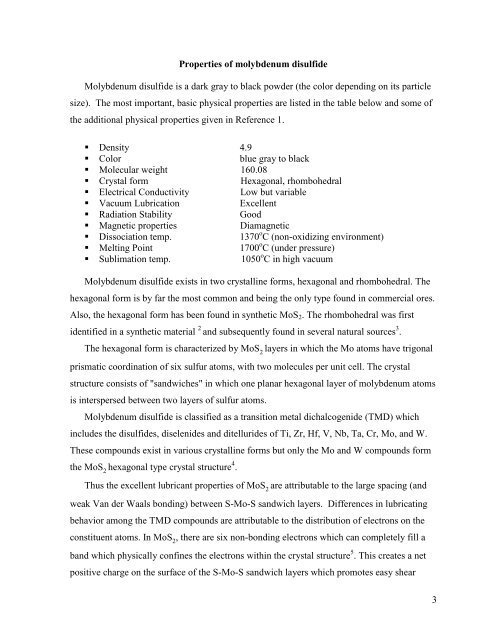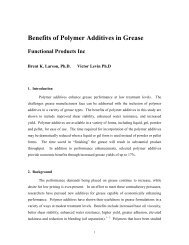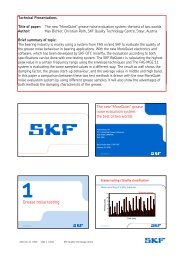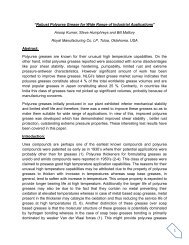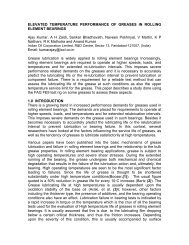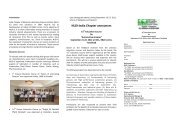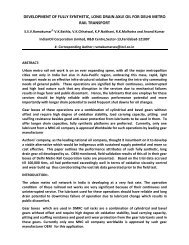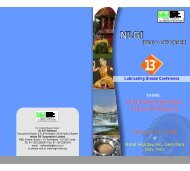Molybdenum Disulfide in Greases - A Review - (NLGI) - India Chapter
Molybdenum Disulfide in Greases - A Review - (NLGI) - India Chapter
Molybdenum Disulfide in Greases - A Review - (NLGI) - India Chapter
Create successful ePaper yourself
Turn your PDF publications into a flip-book with our unique Google optimized e-Paper software.
Properties of molybdenum disulfide<strong>Molybdenum</strong> disulfide is a dark gray to black powder (the color depend<strong>in</strong>g on its particlesize). The most important, basic physical properties are listed <strong>in</strong> the table below and some ofthe additional physical properties given <strong>in</strong> Reference 1.• Density 4.9• Color blue gray to black• Molecular weight 160.08• Crystal form Hexagonal, rhombohedral• Electrical Conductivity Low but variable• Vacuum Lubrication Excellent• Radiation Stability Good• Magnetic properties Diamagnetic• Dissociation temp. 1370 o C (non-oxidiz<strong>in</strong>g environment)• Melt<strong>in</strong>g Po<strong>in</strong>t 1700 o C (under pressure)• Sublimation temp. 1050 o C <strong>in</strong> high vacuum<strong>Molybdenum</strong> disulfide exists <strong>in</strong> two crystall<strong>in</strong>e forms, hexagonal and rhombohedral. Thehexagonal form is by far the most common and be<strong>in</strong>g the only type found <strong>in</strong> commercial ores.Also, the hexagonal form has been found <strong>in</strong> synthetic MoS 2 . The rhombohedral was firstidentified <strong>in</strong> a synthetic material 2 and subsequently found <strong>in</strong> several natural sources 3 .The hexagonal form is characterized by MoS 2layers <strong>in</strong> which the Mo atoms have trigonalprismatic coord<strong>in</strong>ation of six sulfur atoms, with two molecules per unit cell. The crystalstructure consists of "sandwiches" <strong>in</strong> which one planar hexagonal layer of molybdenum atomsis <strong>in</strong>terspersed between two layers of sulfur atoms.<strong>Molybdenum</strong> disulfide is classified as a transition metal dichalcogenide (TMD) which<strong>in</strong>cludes the disulfides, diselenides and ditellurides of Ti, Zr, Hf, V, Nb, Ta, Cr, Mo, and W.These compounds exist <strong>in</strong> various crystall<strong>in</strong>e forms but only the Mo and W compounds formthe MoS 2hexagonal type crystal structure 4 .Thus the excellent lubricant properties of MoS 2are attributable to the large spac<strong>in</strong>g (andweak Van der Waals bond<strong>in</strong>g) between S-Mo-S sandwich layers. Differences <strong>in</strong> lubricat<strong>in</strong>gbehavior among the TMD compounds are attributable to the distribution of electrons on theconstituent atoms. In MoS 2, there are six non-bond<strong>in</strong>g electrons which can completely fill aband which physically conf<strong>in</strong>es the electrons with<strong>in</strong> the crystal structure 5 . This creates a netpositive charge on the surface of the S-Mo-S sandwich layers which promotes easy shear3


